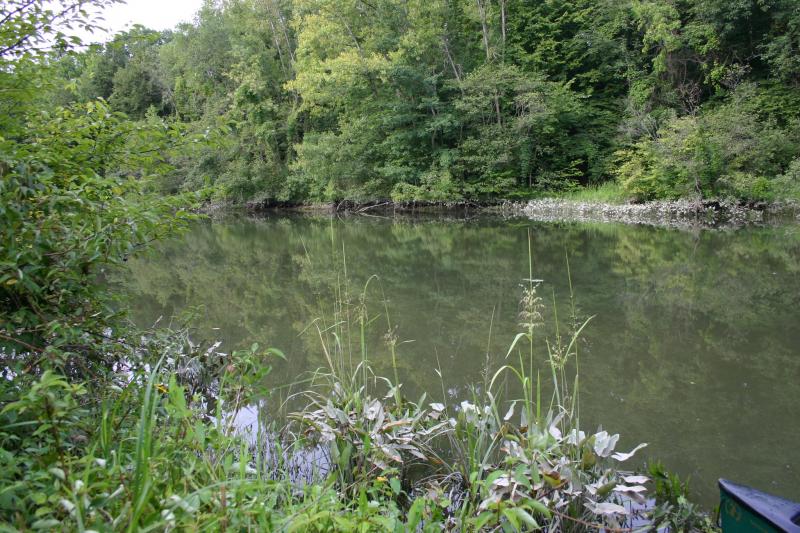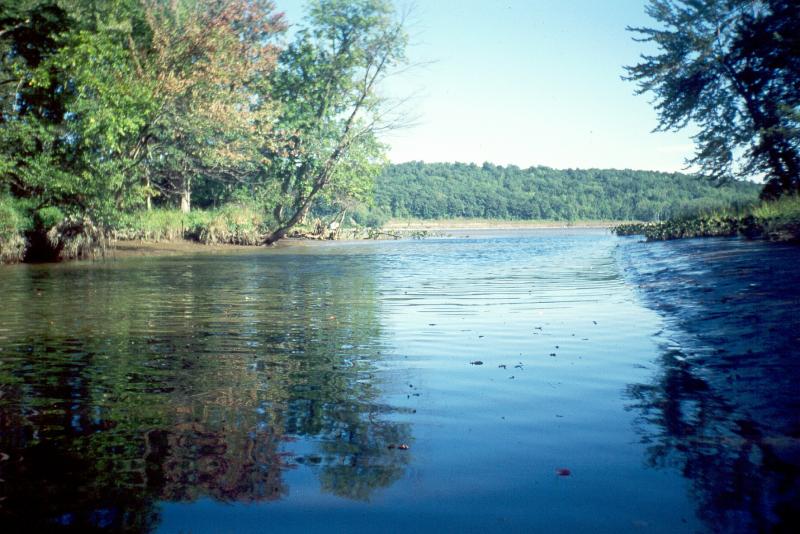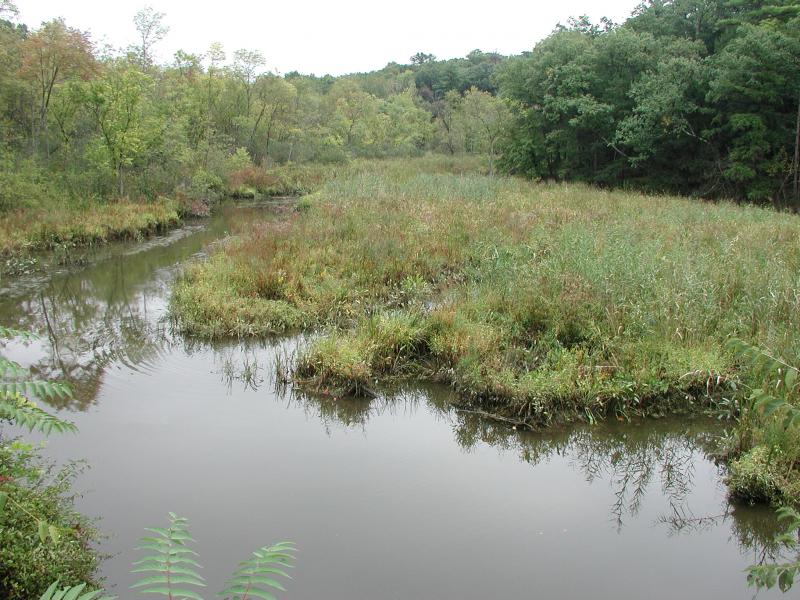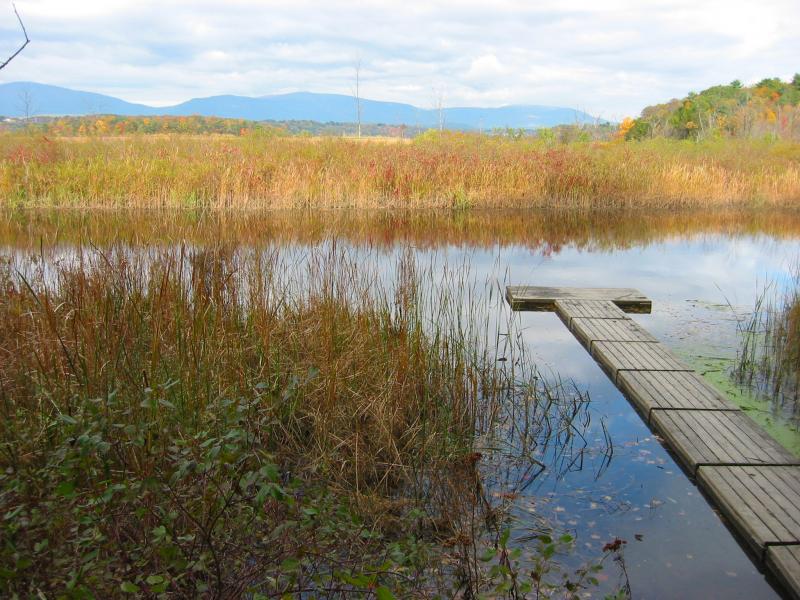Freshwater Tidal Creek
- System
- Estuarine
- Subsystem
- Estuarine Subtidal
- State Protection
- Not Listed
Not listed or protected by New York State.
- Federal Protection
- Not Listed
- State Conservation Status Rank
- S2
Imperiled in New York - Very vulnerable to disappearing from New York due to rarity or other factors; typically 6 to 20 populations or locations in New York, very few individuals, very restricted range, few remaining acres (or miles of stream), and/or steep declines.
- Global Conservation Status Rank
- G3G4
Vulnerable globally, or Apparently Secure - At moderate risk of extinction, with relatively few populations or locations in the world, few individuals, and/or restricted range; or uncommon but not rare globally; may be rare in some parts of its range; possibly some cause for long-term concern due to declines or other factors. More information is needed to assign either G3 or G4.
Summary
Did you know?
Fragrant waterlily (Nymphaea odorata) is a plant that can be found in freshwater tidal creeks and other freshwater open wetlands. Its showy flower and leaves float on the water surface, attached to stems that originate from the root at the soil surface underwater. This plant's roots, leaves, and seeds are widely used as a food plant by native wildlife, such as beaver, muskrat, ducks, and deer. In addition, Native Americans used this plant in teas to treat coughs, mouth sores, and lung infections, and as food, by grinding the rhizomes into flour and frying the seeds.
State Ranking Justification
This community is restricted to the freshwater tidal areas of the state. The majority of occurrences are on the Hudson River in Greene, Columbia, and Dutchess Counties. There are estimated to be about 40 occurrences in the state. Several of these occurrences are threatened because of shoreline development and invasive plants.
Short-term Trends
The number and miles of freshwater tidal creeks in New York have probably remained stable in recent decades as a result of water quality and wetland protectection regulations.
Long-term Trends
The number of freshwater tidal creeks in New York probably declined moderately from historical numbers as a result of shoreline development and river channel dredging.
Conservation and Management
Threats
Freshwater tidal creeks are threatened by development and its associated run-off (e.g., residential, agricultural, roads, bridges), habitat alteration in the adjacent landscape (e.g., logging, pollution run-off), and alteration to the natural tidal hydrology (e.g., impoundments, blocked culverts, stream channelization, water diversions, bank stabilization). Reduction in water quality is a threat to freshwater tidal creeks (e.g., siltation, trash, turbidity, septic/nutrient run-off, pesticides). Freshwater tidal creeks are threatened by invasive, non-native plants, such as Eurasion water-milfoil (Myriophyllum spicatum) and water chestnut (Trapa natans), and animals, such as zebra mussels (Dreissena polymorpha) and non-native snails (Bithynia tentacula).
Conservation Strategies and Management Practices
Where practical, establish and maintain a tidal creek buffer to reduce storm-water, pollution, and nutrient run-off, while simultaneously capturing sediments before they reach the freshwater tidal creek. Buffer width should take into account the erodibility of the surrounding soils, slope steepness, and current land use. If possible, minimize the number and size of impervious surfaces in the surrounding landscape. Avoid habitat alteration within the creek and surrounding landscape. For example, roads should not be routed through the riparian buffer area. If the creek must be crossed, then bridges are preferred over filling and culverts. Restore past impacts, such as removing obsolete impoundments and ditches in order to restore the natural tidal hydrology. Prevent the spread of invasive exotic species into the river through appropriate direct management, and by minimizing potential dispersal corridors.
Development and Mitigation Considerations
Buffers that diminish or eliminate disturbances in this estuarine community are critical considerations for any development project. Such disturbances include the influx of water-borne solutes (e.g., road salt, fertilizers, herbicides, pesticides, sewage), water-borne sediments, and noise pollution. Strive to minimize or eliminate hardened shorelines and maintain very low-sloped shorelines within the tidal zone. Maintain high connectivity between the freshwater tidal creeks and the tidal river, as well as with tidal marshes to encourage full tidal flushing during each tidal cycle. For example, barriers such as railway causeways should have numerous culverts to allow sufficient hydrologic connectivity.
Inventory Needs
Continue searching for large freshwater tidal creeks in good condition (A- to AB-ranked), prioritizing creeks that are associated with other high quality freshwater tidal natural communities (e.g., freshwater tidal marshes, freshwater intertidal mudflats, freshwater tidal swamps, etc.). Survey for occurrences on Long Island.
Research Needs
Collect sufficient quantitative data on the characteristic flora and fauna of freshwater tidal creeks. Research the effects of invasive exotic plants and animals on freshwater tidal creeks.
Rare Species
- Acipenser brevirostrum (Shortnose Sturgeon) (guide)
- Bidens bidentoides (Estuary Beggar Ticks) (guide)
- Cardamine longii (Long's Bittercress) (guide)
- Carex bullata (Button Sedge) (guide)
- Eriocaulon parkeri (Estuary Hatpins) (guide)
- Kinosternon subrubrum (Eastern Mud Turtle) (guide)
- Ligumia nasuta (Eastern Pondmussel) (guide)
- Orontium aquaticum (Golden Club) (guide)
- Plantago cordata (Heart-leaved Plantain) (guide)
- Strongylura marina (Atlantic Needlefish) (guide)
Range
New York State Distribution
This community is currently restricted to the central Hudson Valley portion of the Hudson River, ranging from Rensselaer County to Rockland County, with most occurring in Columbia, Green, Dutchess, and Ulster Counties. Small examples of freshwater tidal creek also occur on Long Island (e.g., the upper reaches of the Nissequoge and Carmans Rivers).
Global Distribution
Freshwater tidal creeks are tributaries to tidal rivers on the Atlantic Coastal Plain from Maine to North Carolina.
Best Places to See
- Catskill Marsh (Greene County)
- Tivoli Bay Wildlife Management Area
Identification Comments
General Description
The aquatic community of shallow, continuously semidiurnally tidally flooded shallow creeks with water salinity values 0 to 0.5 parts per thousand (ppt). Water levels fluctuate with the tides and two community depth zones are typically encountered: 1) the subtidal, permanently flooded, portion of the creek and 2) the intertidal portion including banks and midchannel bars or terraces exposed at low tide. Ecological associations include riffles, runs, pools, and sparsely to non-vegetated creek bottoms. Riffles are dominated by filamentous green algae and Fontinalis spp. Characteristic aquatic plants of runs and pools include tapegrass, or wild celery (Vallisneria americana), bur-weed (Sparganium fluctuans), fragrant waterlily (Nymphaea odorata), and pondweeds (Potamogeton pectinatus, P. natans). A common weedy exotic is Eurasian water-milfoil (Myriophyllum spicatum). The most abundant animals include freshwater shrimp (Gammarus sp.), exotic snails (Bithynia tentacula), stoneflies (Plecoptera), midges (Diamesinae), and aquatic mollusks (Amnicola limosa). The dominant neuston species is an aquatic bug (Mesovelia sp.). The dominant nekton species include banded killifish (Fundulus diaphanus), pumpkinseed sunfish (Lepomis gibbosus), and smallmouth bass (Micropterus dolomieui). Additional characteristic benthic fauna include American eel (Anguilla rostrata), blue crab (Callinectes sapidus), freshwater mussel (Elliptio complanata), and leeches (Placobdella picta).
Characters Most Useful for Identification
Freshwater tidal creeks are continuously semidiurnally tidally flooded, with submerged areas averaging less than 2 m (6 feet) deep at low tide. The water is fresh with salinity values 0 to 0.5 ppt. Emergent, floating, and submerged vegetation are present but sparse.
Elevation Range
Known examples of this community have been found at elevations between -1 feet and 10 feet.
Best Time to See
Freshwater tidal creeks can be accessed during high tide with a canoe; vegetation is best observed during midsummer.
Freshwater Tidal Creek Images
Classification
Characteristic Species
-
Nonvascular plants
- Filamentous green algae
- stoneworts (Chara spp.)
- water mosses (Fontinalis spp.)
-
Emergent aquatics
- Orontium aquaticum (golden-club)
-
Floating-leaved aquatics
- Nymphaea odorata ssp. odorata (fragrant white water-lily)
- Potamogeton natans (floating-leaved pondweed)
- Sparganium fluctuans (floating bur-reed)
- Vallisneria americana (water-celery, tape-grass)
-
Submerged aquatics
- Myriophyllum spicatum (Eurasian water milfoil)
- Stuckenia pectinata (Sago pondweed)
-
Unvegetated
- American black duck (Anas rubripes)
- American eel (Anguilla rostrata)
- amphipods (Gammarus spp.)
- aquatic bug (Mesovelia sp.)
- aquatic flies (Lype spp.)
- aquatic mollusks (Amnicola limosa)
- banded killifish (Fundulus diaphanus)
- belted kingfisher (Ceryle alcyon)
- blue crab (Callinectes sapidus)
- eastern elliptio (Elliptio complanata)
- leeches (Placobdella picta)
- midges (Diamesinae)
- muskrat (Ondatra zibethicus)
- non-native snails (Bithynia tentacula)
- pumpkinseed (Lepomis gibbosus)
- smallmouth bass (Micropterus dolomieui)
- stoneflies (Plecoptera)
- wood duck (Aix sponsa)
Similar Ecological Communities
- Freshwater tidal marsh
(guide)
Freshwater tidal marshes, like tidal creeks, are influenced by diurnal tides, but tidal marshes are not flowing channels, and have diverse and often dense vegetation cover.
- Freshwater tidal swamp
(guide)
Freshwater tidal swamps, like tidal creeks, are influenced by diurnal tides, but tidal swamps are forested or shrub-dominated wetlands occuring in lowlands along a large river channel.
- Tidal river
(guide)
Tidal rivers, like tidal creeks, are continuously semidiurnally tidally inundated channels, but they are much larger and deeper (over 2 m at low tide). Tidal rivers drain much larger geographic areas than tidal creeks, and have more variable salinity values.
Vegetation
Percent cover
This figure helps visualize the structure and "look" or "feel" of a typical Freshwater Tidal Creek. Each bar represents the amount of "coverage" for all the species growing at that height. Because layers overlap (shrubs may grow under trees, for example), the shaded regions can add up to more than 100%.
Additional Resources
References
Edinger, G. J., D. J. Evans, S. Gebauer, T. G. Howard, D. M. Hunt, and A. M. Olivero (editors). 2014. Ecological Communities of New York State. Second Edition. A revised and expanded edition of Carol Reschke’s Ecological Communities of New York State. New York Natural Heritage Program, New York State Department of Environmental Conservation, Albany, NY. https://www.nynhp.org/ecological-communities/
Edinger, Gregory J., D.J. Evans, Shane Gebauer, Timothy G. Howard, David M. Hunt, and Adele M. Olivero (editors). 2002. Ecological Communities of New York State. Second Edition. A revised and expanded edition of Carol Reschke's Ecological Communities of New York State. (Draft for review). New York Natural Heritage Program, New York State Department of Environmental Conservation. Albany, NY. 136 pp.
New York Natural Heritage Program. 2024. New York Natural Heritage Program Databases. Albany, NY.
New York State Department of State, Division of Coastal Resources and Waterfront Revitalization and The Nature Conservancy. 1990. Hudson River Significant Tidal Habitats: A guide to the functions, values, and protection of the river's natural resources. New York State Department of State, Albany, NY. 184 pp.
Reschke, Carol. 1990. Ecological communities of New York State. New York Natural Heritage Program, New York State Department of Environmental Conservation. Latham, NY. 96 pp. plus xi.
Schmidt, Robert E. and Susan Cooper. 1996. A catalog of barriers to upstream movement of migratory fishes in Hudson River Tributaries. Hudsonia Ltd., Bard College Field Station, Annandale, New York. 185 pp.
Links
About This Guide
This guide was authored by: Jennifer Garret
Information for this guide was last updated on: November 3, 2023
Please cite this page as:
New York Natural Heritage Program. 2024.
Online Conservation Guide for
Freshwater tidal creek.
Available from: https://guides.nynhp.org/freshwater-tidal-creek/.
Accessed July 26, 2024.



